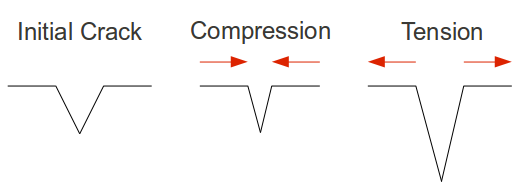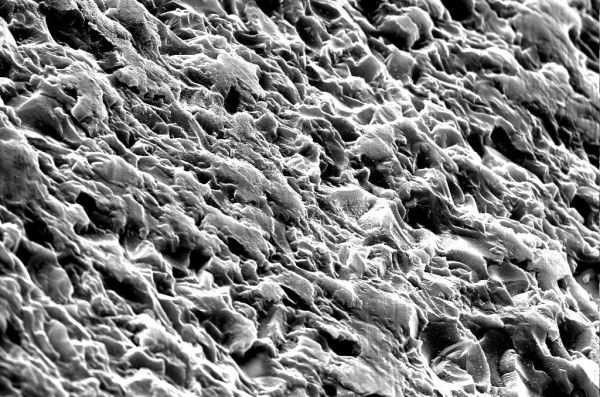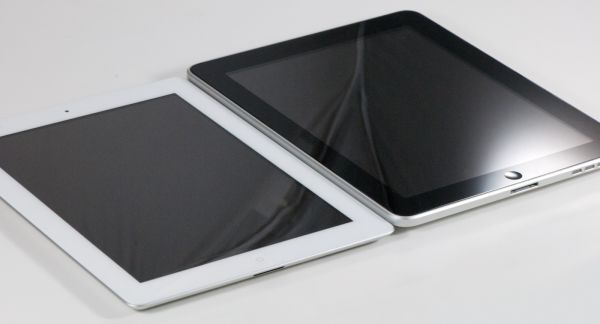The Apple iPad 2 Review
by Brian Klug, Anand Lal Shimpi & Vivek Gowri on March 19, 2011 8:01 PM ESTI asked a friend of mine, Alexander Miles, to write a bit about the properties of glass that really contribute to its overall strength after reading that the iPad 2's glass is 0.62 mm thick compared to 0.85 mm thick in the iPad 1. Hopefully this dispels some myths about glass strength and clarifies. Alex is a senior double majoring in Materials Science and Engineering and Optical Science and Engineering at the University of Arizona.
On the Strength of Glass
We usually think of things failing under compressive stress, being pushed inward from both sides until it they are crushed. Glass and ceramics, it turns out, are incredibly strong in compressive stress. Strictly by the numbers, a fire truck could be supported by a ceramic coffee cup underneath each tire, but only if the load was perfectly downward. Why then are glasses so fragile? This is because no situation causes only compressive stresses, and tensile stress (imagine pulling something from both ends) is what causes glasses to fail. One can think of tiny cracks inside the glass being pushed closed under compressive stress, but torn open under tensile stress.

A schematic illustration of crack behavior in brittle materials.
If you test the tensile strength of thousands of pieces of glass with identical processing and geometry, you will get thousands of different answers. This is markedly different from metals, where you will get nearly the same result every time. The reason being that glass and ceramic materials have a much lower fracture toughness, as much as 100 times smaller than that of a metal. Fracture toughness indicates how easily a crack can propagate, or to phrase it differently, how big a flaw will cause fracture for a given load. As the required load for normal flaw sizes in metals is enormous, metals typically do not fracture in the way glasses do. Metals usually fail in what is called plastic deformation, necking down then tearing away, long before fracture can occur. This plastic deformation is very predictable and follows the stress-strain curve for the given metal, whereas glasses are less predictable.
The question now is, how does the size of a piece of glass affect its behavior under tensile stress? It depends on the distribution of flaws within the material. If you strike a piece of glass with a hammer, a compressive stress is created right below the hammer, but a ring of tensile stress is also created around the spot you hit. You are essentially sampling the distribution of flaws, because if any of the flaws in the affected glass are big enough to widen with the stress you provided, they will rapidly propagate and the material will fracture. The stress field extends down into he material, so flaws in the volume can cause failure as well, though surface flaws are more consistently to blame as the stresses encountered there are almost always larger.

SEM image of a broken glass surface, (CC BY-NC-ND 2.0) attribution St Stev's flickr.
In glasses the distribution of failure stresses is described using Weibull statistics, giving a peak where most samples fail, and tails both on the high and low end where samples had abnormally high and low failure stresses respectively. The long and short of this is that consistently processed samples will have a more narrow distribution as the geometries are scaled down. This means that a thinner piece of glass will have fewer flaws in the bulk and far less likelihood of having a large enough flaw to cause catastrophic failure compared to a thicker piece of glass. The fact that the screens have a large aspect ratio, that is they are far thinner than they are wide or long, means that the effective stiffness will be different in the two directions. Taking this to an extreme, a very thin glass fiber is fairly flexible in bending, but very stiff axially, as its cross-section is so small that very few flaws are contained inside it. If one needs to break a glass fiber, a surface flaw is usually created by scratching it first.
| Approximate values for the strength of common soda lime glass in various conditions | |||||
| Condition | Tensile Strength (MPa) | ||||
| Theoretical Maximum (Flawless) | 9810 | ||||
| 3 Micron Fibers | 3330 | ||||
| Thin rods, fire-polished and acid etched | 3420 | ||||
| Thin rods, no special treatment | 690 | ||||
| Bulk, ion exchange tempered | 350 | ||||
| Bulk, thermally tempered | 300 | ||||
| Bulk, fire-polished and acid etched | 220 | ||||
| Bulk, no special treatment | 50 | ||||
In order to use glass screens on our devices, we would like it to be far tougher, where "tougher'' ideally means both more resistant to fracture as well as more resistant to scratching. There are two basic schemes used to strengthen glass: elimination of the surface flaws, and creation of compressive stress in the bulk of the glass. Eliminating the surface flaws by polishing, fire-polishing (heating them until surface tension flattens out the flaws), and acid-etching does indeed increase the strength, and drastically so. An increase in strength of up to one hundred times can result from such treatment, but is temporary as microscopic scratches from handling will quickly reduce the strength back to what it was before.
The second scheme for improving strength, introducing a compressive layer, works because existing compressive stress in the glass has to be overcome by the induced tensile stress before any cracks can propagate. To say it plainly, if you don't hit it hard enough with a hammer, it will not even see the type of stress that makes it fail. The down side to this method is that every force causes an equal and opposite force, meaning that a lot of compression at the surface causes tension at the center. As long as a crack does not reach the volume with the additional tensile stress imposed on it, the glass will hold together, but once it does it releases the energy kinetically and fails catastrophically (it explodes like a pumpkin with an M80 stuffed in it).
The way this layer is created varies based on the application. For car windshields, they are thermally tempered by chilling the outer surface while the center is still hot, as the surface remains solid while the center is still busy shrinking, which leaves the surface in compression. Similarly, coating the glass object in a second type of glass with a lower thermal expansion will cause the same effect, as the outer surface shrinks the center is shrinking faster. The multiple-glass approach has the additional benefit that cracks have difficultly moving from one type of glass to the next, leading Corning to produce some glasses with as many as 7 layers.
The final method, and most relevant to our discussion, is ion-exchange. Ion-exchange refers to removing small ions, like sodium, from the glass, and replacing them with larger ions like potassium, all at a temperature that prevents the structure of the glass from adjusting itself to these new bigger ions. The way this swap is actually done is by immersing the glass in a molten salt solution containing the ion we want to substitute in, and allowing it to diffuse in over time, while the smaller, more mobile, ion diffuses out. Depending upon the type of glass, the ions being exchanged, and the desired depth, this process can take as long as several days.
The iPad 2 and previous iPad both utilize Corning Gorilla Glass. This type of glass is an alkali-aluminosilicate, being primarily silica and aluminum with an alkali metal, along with other unspecified components mixed in to tweak its properties. The biggest benefit of alluminosilicate glasses, aside from being relatively tough to start with, is the fact that the rate of ion exchange is fairly high even at temperatures low enough that the structure cannot react, meaning it can be processed quickly and create deep protective layers in the glass. The iPad 2 has a modest reduction in the thickness of the glass (about 23% thinner, for those interested) compared to the first iPad, and the question of increased fracture risk has been posed. Given the identical surface quality between the two generations, the reduction of thickness should create no palpable change in toughness for the typical user. That is to say, a drop that would shatter the screen on the original iPad would likely do the same for the new model. That being said, several other design changes appear to account for the change, and might yield better performance in this department.
Where its predecessor used small metal clips to retain the glass screen, the current iteration uses a ring of adhesive around the entire perimeter that not only distributes the load around the glass and prevents scoring at the glass-metal interface, but better couples the stresses into the more compliant aluminum frame. Both of these measures should improve the performance; either way, drop-testing new electronics is generally not recommended.











189 Comments
View All Comments
Mike1111 - Sunday, March 20, 2011 - link
Well, Anandtech is a site for geeks, but shouldn't you have at least mentioned how you think the iPad 2 could fit into the average person's life? People who don't "work" with PCs in their free time and who don't have a dedicated PC workflow?Some thoughts regarding the review:
- I thought the glass was supposed to be from Asahi Glass (Dragontrail)?
- Okay, the Xoom can't play videos with b-frames without problems. But what h.264 videos can the iPad 2 play? Same as iPad? More? High-profile? Blu-ray class h.264 videos?
- I wish you could have gone more in-depth regarding the A5. Why is it so big compared to the Tegra2? How efficient does it work? What kind of video decoder/encoder are used? etc.
Zebo - Sunday, March 20, 2011 - link
Nothin like the real things baby.....I have used a x201 tablet since April of 10 and it's the best investment I ever made. True outdoor viewable with upgraded outdoor IPS screen and 500 nits. true keyboard, true duel core processor, true work machine. I have ATT card to get internet and take it everywhere I go. I bet I travel more than Anand and it's the only way to fly.tcool93 - Sunday, March 20, 2011 - link
I don't even own the Ipad. Yet I do know for a fact there are at least two other browsers you can use with it besides Safari. The Atomic browser, and the Skyfire browser... both supporting tabs and supposedly are much better than Safari. Skyfire even has partial flash support, and viewing social network sites built in (twitter, facebook, etc). Both of those browsers have very good reviews also.secretmanofagent - Sunday, March 20, 2011 - link
I'm starting to play with iCab, but I don't have an iPad.dagamer34 - Sunday, March 20, 2011 - link
3rd party browsers unfortunately don't get the Javascript speedup built into iOS 4.3tipoo - Sunday, March 20, 2011 - link
The javascript engine is built into the browser. Of course they don't get the faster Safari engine, they aren't Safari. They use their own engines.name99 - Sunday, March 20, 2011 - link
Yes and no.The current iOS will no allow third party apps to create code on the fly, so those browsers will not be able to use JIT'ing, even if they wanted to write a sophisticated javascript engine.
On the other hand, Apple is well aware of the limitations of their current browser tech and are actively working on ways to run different parts of the browsing code in different processes (for both performance --- multi-threading, non-blocked UI --- and security reasons), on both OSX and iOS.
When this effort comes to fruition, who knows how much of the underlying tech (in particular, in this case the ability to create code on the fly, perhaps in some sandboxed fashion) will be made available to devs?
Zebo - Sunday, March 20, 2011 - link
You'll never even think about a slate tablet after that.10 hrs battery
all windows apps
plays games
IPS screen (with upgrade)
can use as HTPC when on road
can publish this site effortlessly
I doubt you'll use a another device besides your iphone
VivekGowri - Sunday, March 20, 2011 - link
And I could buy three iPads for the same price. It simply isn't a valid comparison for the same reason the MB Air, Asus Slate, and other $1000+ devices aren't; not in the same category, not even in the same price range. It's like saying that after driving a Mercedes S-class, you'll never think about driving a Lotus Elise or Porsche Boxster ever again - it's not really a useful or valid comparison to make.I don't doubt that the X220t is going to be an excellent, excellent device - fixes every problem I had with the X200/201t, goes back to the IPS display, and it's going to be pretty fast too. It looks pretty awesome, IMO. If I was in the market for a tablet PC (as opposed to a smartphone-based tablet), this and the ASUS Slate would be the only two I'd really look at - the ASUS is kind of like a cheaper version of the X220 except without the built-in keyboard.
snouter - Sunday, March 20, 2011 - link
But I left it on a plane. What did I replace it with? An 11" MacBook Air. Honestly, it's no comparison. The Air can do so many things that the iPad could not. Tablets will stick around and find niche applications in lots of places, but I'd keep my eye on the the super thin super light notebooks. BTW, the Air has a ULV Core 2 Duo 1.6GHz and will get Sandy Bridge in the next update. The processing power is far superior to the tablets and the netbooks. It's everything I wanted to do with my iPad, and it's a notebook when I need it to be. Main main work Laptop is still a 17" MacBook Pro, but none of these tablets, netbooks or ULV laptops are in competition with it. When the next Air comes out with a backlit keyboard and ULV Sandy Bridge, I'll be there.